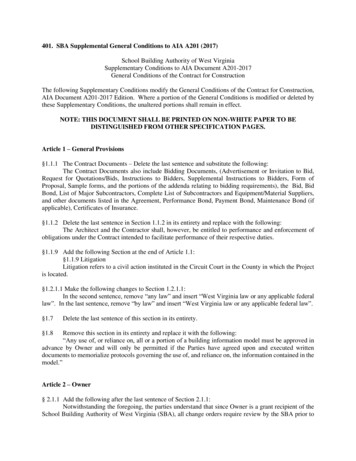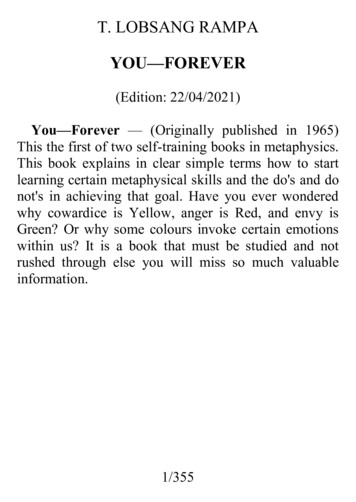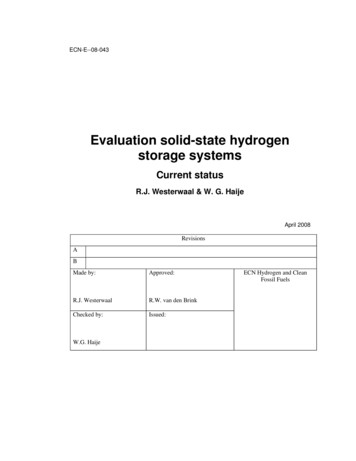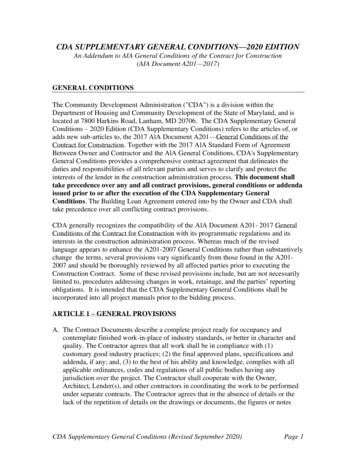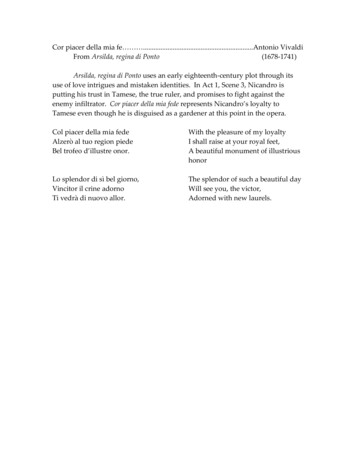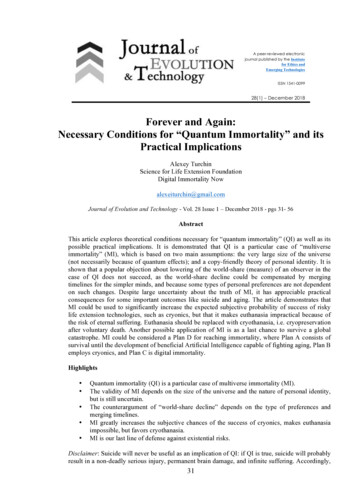
Transcription
A peer-reviewed electronicjournal published by the Institutefor Ethics andEmerging TechnologiesISSN 1541-009928(1) – December 2018Forever and Again:Necessary Conditions for “Quantum Immortality” and itsPractical ImplicationsAlexey TurchinScience for Life Extension FoundationDigital Immortality Nowalexeiturchin@gmail.comJournal of Evolution and Technology - Vol. 28 Issue 1 – December 2018 - pgs 31- 56AbstractThis article explores theoretical conditions necessary for “quantum immortality” (QI) as well as itspossible practical implications. It is demonstrated that QI is a particular case of “multiverseimmortality” (MI), which is based on two main assumptions: the very large size of the universe(not necessarily because of quantum effects); and a copy-friendly theory of personal identity. It isshown that a popular objection about lowering of the world-share (measure) of an observer in thecase of QI does not succeed, as the world-share decline could be compensated by mergingtimelines for the simpler minds, and because some types of personal preferences are not dependenton such changes. Despite large uncertainty about the truth of MI, it has appreciable practicalconsequences for some important outcomes like suicide and aging. The article demonstrates thatMI could be used to significantly increase the expected subjective probability of success of riskylife extension technologies, such as cryonics, but that it makes euthanasia impractical because ofthe risk of eternal suffering. Euthanasia should be replaced with cryothanasia, i.e. cryopreservationafter voluntary death. Another possible application of MI is as a last chance to survive a globalcatastrophe. MI could be considered a Plan D for reaching immortality, where Plan A consists ofsurvival until the development of beneficial Artificial Intelligence capable of fighting aging, Plan Bemploys cryonics, and Plan C is digital immortality.Highlights Quantum immortality (QI) is a particular case of multiverse immortality (MI).The validity of MI depends on the size of the universe and the nature of personal identity,but is still uncertain.The counterargument of “world-share decline” depends on the type of preferences andmerging timelines.MI greatly increases the subjective chances of the success of cryonics, makes euthanasiaimpossible, but favors cryothanasia.MI is our last line of defense against existential risks.Disclaimer: Suicide will never be useful as an implication of QI: if QI is true, suicide will probablyresult in a non-deadly serious injury, permanent brain damage, and infinite suffering. Accordingly,31
the idea of QI is not an argument for suicide, but is one of the strongest arguments against it. If youare interested in suicide, seek professional psychological help.Warning: Memetic hazard for people who tend to react emotionally to thought experiments!AbbreviationsAI – Artificial IntelligenceQS – Quantum suicide (or quantum suicide thought experiment)QI – Quantum immortalityMI – Multiverse immortality: umbrella term for QI and big world immortalityMWI – Many-worlds interpretation of quantum mechanicsUDT – Updateless Decision Theory1. IntroductionThe main idea behind quantum immortality (QI) is that constant branching of the multiverse – accordingto the many-worlds interpretation (MWI) of quantum mechanics – ensures the existence of timelines inwhich a given observer will survive any dangerous situation. The idea was suggested in the form of aquantum suicide (QS) thought experiment by Tegmark (1998) and others.Most scientists who have written about the idea of QI have felt an obligation to disprove it (Randall 2004;Mallah 2009; Almond 2011a; Aranyosi 2012),1 in the same way as most authors try to disprove thenotorious Doomsday argument (Bostrom 1999), which is commonly interpreted as supporting apessimistic estimate of how long humanity will survive as a species. Critics of QI do not analyze theimplications if QI is true, and as result, the possible practical consequences of the idea are underexplored.Quantum immortality is closely related to the effective altruism circle of problems. If QI is real, it followsthat there is a possibility of infinite future suffering for any sentient being (Aranyosi 2012), as it will notbe able to die, but will continue to age. So, QI is an s-risk. The concept of an s-risk was introduced byMax Daniel (2017) to denote risks whose outcomes could include “suffering on an astronomical scale,vastly exceeding all suffering that has existed on Earth so far.”2 In what follows, however, it will bedemonstrated that there is a way to prevent this s-risk for people who are currently alive. This involvesincreasing their possible positive timelines, extending into the infinite future, by signing up to cryonicsuspension and storage.3An overview of the history of the idea of QI, its formalism, and its relation to the idea of death ispresented in Section 2. Section 3 is devoted to the difference between QI and multiverse immortality(MI), and the conditions necessary for them to be true are analyzed. Section 4 explains the possible badconsequences of “natural” QI. In Section 5, QI is explored from the point of view of decision theory, andthe “measure decline” objection is analyzed. Section 6 provides an overview of the practical applicationsof QI, including overcoming the negative effects of natural QI via cryothanasia (cryopreservation aftervoluntary death).2. The nature and formalism of multiverse immortality2.1 History of the ideaThe first stage of the concept that the infinite size of the universe implies some form of immortality wasthe idea of so-called eternal return, that is, the repeated appearance of the same observers. The earliestversions of the eternal return theory appeared in ancient philosophy (Eliade 1949) and still attract interesttoday (Bergström 2012). Empedocles of Akragas reportedly believed in the cyclic return of everythingbased on the recombination of four elements, ensuring personal immortality (Brown 1984).In more recent thought, the idea that an infinite universe implies some form of immortality came toRomantic poet Heinrich Heine in the first half of the nineteenth century. He wrote:32
For time is infinite, but the things in time, the concrete bodies, are finite. They may indeed disperseinto the smallest particles; but these particles, the atoms, have their determinate number, and thenumber of the configurations that, all of themselves, are formed out of them is also determinate.Now, however long a time may pass, according to the eternal laws governing the combinations ofthis eternal play of repetition, all configurations that have previously existed on this earth must yetmeet, attract, repulse, kiss, and corrupt each other again. (Kaufmann 2013, 318)The idea of “cyclic immortality” was postulated by French socialist Louis Blanqui in his bookImmortality Through the Stars (1872). Friedrich Nietzsche arrived at the same idea, his famous theory ofeternal return or eternal recurrence, in the 1880s: he recorded in his notes that it first occurred to him inAugust 1881, and he published the idea in 1882, in the first edition of The Gay Science. Subsequently, itbecame a central idea in Thus Spoke Zarathustra (originally published 1883–1891), in which acceptanceof the possibility of eternal recurrence is a defining feature of the Übermensch. However, Nietzsche eitherdid not understand or ignored the obvious consequence of eternal recurrence, that there will always be aworld, similar to our world until the moment of the observer’s death, but different in the moment of thedeath in such a way that the observer will not die. This implies immortality from the subjective view ofany observer. Thus, the idea of MI (of which QI is an important specific case) is a natural development ofNietzsche’s idea.Hugh Everett, working on quantum mechanics in the middle of the twentieth century, was probably thefirst person to come to the idea that a constantly branching universe implies immortality from thesubjective point of view, based on his discovery of MWI as an interpretation of quantum mechanics.However, he never stated this conclusion publicly (Shikhovtsev 2003). It was only at the end of thetwentieth century that the key idea for current purposes – that the existence of the multiverse impliessome form of immortality – became known as “quantum immortality” following the “quantum suicide”(QS) thought experiment proposed by Moravec (1988), Marchal (1991), and Squires (1994), and laterpopularized by Tegmark (1998).The preservation of information implicit in quantum mechanics, and known as the “no-hide theorem”(Braunstein and Pati 2007), is not connected with the idea of QI as it was originally presented byTegmark and others. In the original QI theory, human survival happens in only one of the branches of thequantum multiverse, and preservation of the information in other branches is not necessary. However,such quantum preservation could be used by another approach to the resurrection of the dead, i.e.“quantum archeology,” which is out of the scope of this paper, but has been addressed elsewhere by theauthor (Turchin and Chernyakov 2018) and by Jonathan Jones (2017).Previous work has sought to identify the truth or falsity, and the practical features, of QI, but the idea hasonly a few vocal proponents. In the 1990s, Higgo (1998) tried to present QI as a legitimate theory ofimmortality, but his analysis is not deep. About the same time, Robert Charles Wilson explored thepossible consequences of quantum immortality in his short story “Divided by Infinity” (first published in1998 in the anthology Starlight 2, edited by Patrick Nielsen Hayden), in which the protagonist survivesmultiple suicide attempts (and even a global catastrophe) and is resurrected by aliens.Allan F. Randall (2004) criticizes QI from the point of view that its most likely outcome is neither“technological resurrection” nor “eternal decrepitude,” but chaotic random observers similar toBoltzmann brains. He does, however, note the usefulness of QI for cryonics. Brett Bevers (2011) exploreshow QI relates to the Born rule, a central principle in quantum mechanics, and apparently breaks it. MilanM. Ćirković (2006) correctly mentions that a theory of personal identity is critical for QI, and proceeds toprove that, in the case of QI, subjective credence should be equal to the objective probabilities. PaulAlmond (2011) extensively criticizes the idea that the QS thought experiment could be used as a proof ofMWI. Elsewhere (Almond 2008), he suggests that QS could be a “universal problem solver,” and that theconcept of civilizational-level QS could be used to explain the Fermi paradox.Greg Egan’s idea of “dust theory” (see Egan 2009)4 seems to be the next step in developing the idea ofQI, similar in significance to the step from the eternal recurrence in the nineteenth century to the latetwentieth-century QS thought experiment. In dust theory, something similar to QI happens in every33
observer-moment; such moments could exist completely separately from each other, as random patternsin infinite “dust,” or as Boltzmann brains, but could look subjectively connected “from inside” based ontheir similarity. An important conclusion of such a theory is that there is no need for an external realityother than the unstructured and endless dust, and that each observer-moment could have many pasts andmany futures. The mathematical theory of such a world was recently suggested by Marcus P. Müller(2018). The truth or otherwise of such récherché theories is, however, out of the scope of this paper;rather, the actual existence of an objective and structured world, governed by observer-independent lawsof physics, is assumed throughout.Christian Loew (2017) has suggested an idea similar to Egan’s dust theory, that of “Boltzmannianimmortality,” which is basically a reincarnation of the eternal return that takes into account Boltzmannbrains randomly appearing from vacuum if an empty universe lasts for an infinitely long period.2.2 The quantum suicide thought experiment and infinite survival timelinesThe main idea of the QS thought experiment is that a quantum event, such as radioactive decay of anatom, will trigger a powerful bomb near me, an observer, with a probability5 of 0.5. In such a situation,two future timelines are possible, depending on whether or not the bomb explodes. If MWI is true, bothtimelines are real. In one, I continue to exist, and in the other I am instantly destroyed. Thus, I willobserve only the timeline in which the bomb didn’t explode. This experiment seems similar to the famousthought experiment involving Schrödinger’s cat, but without the tantalizing idea that the observer couldbe in a superposition of dead and alive states.Thus, QS entails that an observer will always observe a winning result in Russian roulette, which mayseem (to them) as if they have surprising skills of survival. The main question is whether the inevitableobservation of not dying in such an experiment can be equated to subjective immortality: in MWI, therewill always be a timeline in which the bomb didn’t explode after any number of attempts – but is thisenough to conclude that the observer is immortal?The QS thought experiment has also been analyzed as a possible proof for MWI: how many failedattempts at suicide are enough for an observer to conclude that the MWI is true? Almond and others haveinvested significant time in proving that no number of instances of survival in QS could be a proof ofMWI. However, as Bostrom notes (2002), if observations are discarded based on the assumption that inan infinite universe there exists an observer for any possible observation, science is not possible asobservation loses its predictive power.While QS requires exotic devices, such as a bomb and a quantum random generator, there is no reason tothink that any ordinary cause of death is different. Dying will be more complex, but eventually there willbe two main types of future timelines: those in which I died and those in which I survived. However,slower dying implies some more complex dynamic, such as an increased probability of survival in aninjured state that includes suffering. This will be addressed later.In a nutshell, QS entails some form of QI – “quantum immortality” – i.e., for any observer, there is (atleast one) infinite future timeline in which that observer will continue to exist. However, as will be shownin the next section, such a result could happen not only in a quantum world, but even in a completelyclassical world, if some conditions held relating to the world’s size and the observer’s internal structure.2.3 Formalism of multiverse immortalityOne useful instrument when speaking about observers is the idea of “observer-moments,” that is, theshortest periods of subjective experience, probably corresponding to one step of the internal human clock(which has a duration of a few tens of a millisecond). For simplicity’s sake, it is assumed here that anyobserver-moment is characterized by the name I and a time-stamp t, and the observer-moment is thusnotated as O(I, t). Then, immortality can be defined as the following statement: For any observer-momentO(I, t) there necessarily exists (at least one) observer-moment O(I, t 1). The following is immediatelyimplied: There is no last observer-moment O(I, tlast), so there is no death.34
Note that there is a hidden claim that the existence of O(I, t 1) is sufficient for immortality. This exactclaim typically raises the most objections: while some might agree that somewhere in the multiverse thereexists a copy of me which survived my death, they claim that such existence is not immortality quaimmortality because of a different identity, or lower “measure,” or some decision-theoreticconsiderations. Some of these objections will be discussed in the sections that follow.The definition of immortality involved here is general and – hypothetically – could be satisfied throughmany conceivable processes (e.g. God created the world this way). What is claimed in MI theory is thatthe infinitely large size of the universe is sufficient to satisfy the immortality definition (given a few otherassumptions).2.5 The logical indefinability of the observer’s deathThere is a well-known conjecture that is expressed in the following syllogism: “All humans are mortal(i.e. will die), I am a human, so I am mortal (i.e. I will die).” Though it is well-known, it has severalflaws. One is the “fallacy of four terms” (Copi and Cohen 1990), as the concept of mortality (and henceof death) has different meanings in the first premise of the syllogism and in its conclusion. In the premise,the concept of death is “death-for-others”, i.e. observation of death by outside observers, or cessation ofthe living activity of the body. In the conclusion, the concept of “death-for-me” is used, which means thedeath of the observer from the observer’s point of view, typically expressed by the idea of “nothingnessafter death” or cessation of the process of observation. However, by definition, no one can experience andreport anything about nothingness after death, so it is not possible to prove that it will actually happen.Multiverse immortality means that death – from the observer’s point of view – is impossible. In otherwords, for any state of any observer with time-stamp t0, there is a possible next state t0 1, and, aseverything possible exists, such an observer exists. Thus, a last moment of experience is impossible, anddeath – as the cessation of the process of experiencing – is impossible. Almond (2011b) attacks this ideaand notes that if MWI is not true, the death of the observer is a consistent explanation of reality, but if it isassumed that the MWI is true, death in some branches immediately becomes an inconsistent explanation.According to Almond’s work, this jump between varying descriptions of death is not logical andundermines the idea of QI. In other words, if it is agreed that death is theoretically possible, because of asmall world, it should also be agreed that death is possible in the branching world, in the form of thedeath of some branches. This is not a question of fact, but one of interpretation: should the continuedexistence of a person’s quantum duplicate (or some other kind of copy) be regarded as immortality ornot?The answer to the problem raised by Almond is connected with the nature of personal identity, which willbe analyzed in the next section. If identity is connected with the measure of existence, then there is someprobability that lowering this measure is equal to death. If identity depends only on information, then achange in the number of copies is irrelevant. The nature of death depends on the nature of personalidentity, and death could be described as “the end of identity.” Another counterargument is that if I amnot currently on Mars, that doesn’t mean that I am dead on Mars. In any given moment, there are a lot ofbranches which are not happening with me, but it doesn’t mean that I die every moment – and if the nonexistence of a branch is considered a death, I am dying every second in millions of ways.2.6 Examples of multiverse immortalityThere is nothing strange in the idea of MI, when simpler objects and beings are considered:Numbers are immortal. All numbers appear over and over again in multiple worlds, and it could be saidthat any given number is “immortal.” In principle, the same is true for number series: the number 27 willappear again and again, but we are not surprised by this, as the number is small compared to the size ofour world, where we can find, for example, 27 ships and 27 sheep. The repetition of longer numbers inthe world becomes more and more surprising – but only because the world seems to be too small for suchrepetition. In an infinitely large and random world, any number or series of numbers will repeat.35
Simple molecules are immortal. A molecule of water will appear again and again, because it is verysimple, and consists of abundant components. But more complex compounds are rare. Some short organicmolecules are likely to repeat rather often, while a molecule with around 100 randomly connected atomswill be so rare that it might appear only once in our Hubble volume. In other words, the simpler theobject, and the more stochastic its environment, the more likely it will possess something like MI.Biological viruses. Even some living beings could enjoy this type of immortality in an observable way.Biological viruses of one species are all functionally equivalent to each other (barring mutation) and thedeath of one copy is not the death of the virus.2.7 Overview of the types of multiverse immortality“Multiverse immortality” – MI – will be used in what follows as a general term that unites three subtypes.However, these subtypes may have no observational differences: eternal return will look like QI ifsomeone’s life history completely repeats in the future until the moment of death, but, in that moment,becomes different – and the only difference is that the person will not die. All three types are identified inTable 1 below and depicted pictorially in Figures 1–3.A useful metaphor to understand MI is the thought experiment that provides the basis of Jorge LuisBorges’ short story “The Library of Babel” (originally published in Spanish, 1941; English translation1962). In the library of Babel, an infinite number of copies of all possible books exists. If one copy of abook disappears, the book still exists within the library, maybe different in just a few typographicalerrors.In passing, it should be noted that a different meaning of the term “quantum immortality” is sometimesdiscussed. In this sense, QI is a form of near-death experience after which a person jumps backward to anearlier point in their life and relives the moment of a dangerous situation (typically, a car accident)without dying.6 While some people do have this experience as a hallucination, it is not the original idea ofQI, which cannot be reported to outside observers, and in which there are no temporal jumps. Quantumimmortality does not require a “quantum mind” or other quantum woo: it is based solely on MWI, ascientifically respected interpretation of quantum mechanics. It does not require any quantum effectsexcept the existence of observer copies in other branches of a multiverse.Table 1. Types of multiverse immortalitySubtypeMultiverse immortalityUnderlying properties of themultiverseEternal return with alternative Infinite in timeendingBig world immortalityInfinite in space or parallelworldsQuantum immortalityMany-worlds interpretation ofquantum mechanics36
Figure 1. Eternal return with an alternative ending at the moment of death.Figure 2. Big world immortality. There is another copy of an observer in a causally disconnected regionof the universe, and this observer-copy does not die at the moment of the observer’s death.Figure 3. Quantum immortality. There is always a branch of the multiverse in which the observer doesnot die. Smaller circles represent “measure decline;” the green line indicates the timeline of survival.3. Necessary conditions for multiverse immortality: The huge size of the universe and a “copyfriendly” theory of personal identityTwo conditions are essential for MI: that there exists an infinite number of copies of an observer withalternative life histories, and that the replacement of an observer with its exact copy is a sufficientcondition for immortality.37
The first condition is factual: it is a claim that the universe is built in such a way that, for any situation inwhich an observer has died, there exists another copy of the same observer who lived through that exactmoment. Note that this condition is realized by different physical mechanisms for QI and for big worldimmortality. In the first case, however, it is realized via branching of the world wave function, while inthe second case, the universe is so large that such copies will appear in it because of combinatorialeffects. While the mechanisms are different, the result is the same: infinitely many copies ensure theexistence of endless chains of observer-moments.7The second condition is not a factual claim, but a decision-theoretic one; it states that an individual shouldact as if she is immortal after she learns the first factual condition (and assuming some type of subjectcentered preferences). Both conditions will be explored in detail in this section.3.1 Condition 1: Repetition of human minds in the universe3.1.1 Tegmark’s levels of multiverseMax Tegmark (Tegmark 2009) identified four levels of the multiverse sufficient to create a world largeenough to include all possible observers’ minds, at least those the size of a human mind. These are asfollows:Level 1. Regions beyond our cosmic horizon, that is the very large size of our own bubble. “Ageneric prediction of cosmological inflation is an infinite ‘ergodic’ space, which contains Hubblevolumes realizing all initial conditions — including an identical copy of you about 1010 29 maway” (Tegmark 2009). The scale of chaotic inflation is supported by observations of anisotropy.One estimate is 10 {10 {10 {122}}} megaparsecs (Page 2007).Level 2. Other post-inflation bubbles. Quantum foam during the Big Bang creates many bubbleswith differing laws of physics. Their existence is supported by ideas that fine-tuning of physicallaws is explained by the observer selection effect, also known as the anthropic principle.Level 3. Many worlds interpretation of quantum mechanics.Level 4. Mathematical universe: all possible mathematical structures exist. This is the mostsimple explanation of the fact that everything exists at all.The first level is tentatively supported by data from contemporary cosmology, first of all, cosmologicalinflation, as explained by Tegmark. So, big world immortality in a very large universe receives evenstronger scientific support than QI, which is based on an interpretation of quantum mechanics thatcurrently remains untestable. However, all this evidence is indirect and is merely an extrapolation of ourbest theories of cosmology. Some other cosmological theories also allow MI, e.g. a cyclic universe, aspatially finite universe that exists for an infinitely long time via a series of Big Bangs and Big Crunches(Steinhart and Turok 2002), and a fecund universe that replicates via black holes (Smolin 1992).The anthropic principle in a fine-tuned universe can also be regarded as evidence for a very large universewith a variety of possible physical constants (Bradley 2009), since numerous “attempts” are required tocreate the right combination. By some estimates, as many as 10500 instances might be required just toarrive at the optimal combination of physical constants.8 There are many cosmological theories, but it isnot easy to create a viable cosmological theory that results in just one small universe that is fine-tuned forlife; in a sense, it is computationally simpler to devise a process that creates all possible universes.The more general argument for an infinite universe is philosophical. There is a process that makes theuniverse appear from “nothing,” as could be concluded from the fact of the universe’s existence. For anon-infinite universe, this process must stop at some point, preventing new universes from appearing. Butstopping this process would require a force acting on nothingness, i.e. from beyond the universe.However, the universe is, by definition, the only thing which exists: there can be nothing beyond it. Thus,the process that created the universe cannot be exhausted. Approximately the same logic was presented38
by Kant in his Critique of Pure Reason (originally published 1781). Among Kant’s celebrated“antinomies,” was that relating to the finite or infinite extent of the universe in time and space, whereboth alternatives were said to be paradoxical. There is, however, a possible solution: that the universe isneither finite nor infinite, but is instead constantly growing.One attractive property of Tegmark’s levels 1 and 2 is that they are only currently causally disconnected.They arose from the same causal process of the same Big Bang, and thus could become connected againat some time vastly distant in the future. So, copies from levels 1 and 2 have the same ontological statusof actual existence (i.e. actuality, see Section 3.1.4) as any other object in the observable universe,including even your next-door neighbor.Some scientists do not subscribe to theories of a multiverse (e.g. Hossenfelder 2018). The main argumentof these critics is that, as other universes are non-observable, they are beyond real science – but thisargument is obviously circular. It is, of course, difficult to prove that the universe is infinite, but to provethat it is finite is impossible, so MI cannot be disproved. Interestingly, for MI, it is not necessary that“everything possible exists” or even that the universe is of infinite size; it is only necessary that theuniverse is very large.Another possible objection to the big world is the idea that only “me-now” actually exists – similar to the“moving spotlight theory” of now (Deasy 2015), “actual now” (Bitbol 1994), and “ontological privilege”of now (Frischhut and Skiles 2013) – and everything unobservable doesn’t exist. But even this will notkill the theory of multiverse immortality, as in that case, consciousness becomes an ontological necessitythat helps to create the now-moment and thus can’t be turned off.3.1.2 The finite size of human mindsNot only does the universe need to be huge, but human minds need to be finite in size for multiverseimmortality to exist. As the human brain consists of a finite number of atoms (around 5x1026), it seems tobe finite. Tegmark shows that quantum effects do not prevent the number of states from being finite, asany quantum system in the finite space could
The idea of “cyclic immortality” was postulated by French socialist Louis Blanqui in his book Immortality Through the Stars (1872). Friedrich Nietzsche arrived at the same idea, his famous theory of eternal return or eternal recurrence, in the 1880s:

